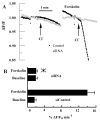Dependence of cAMP meditated increases in Cl- and HCO(3)- permeability on CFTR in bovine corneal endothelial cells
- PMID: 18325495
- PMCID: PMC2376055
- DOI: 10.1016/j.exer.2008.01.017
Dependence of cAMP meditated increases in Cl- and HCO(3)- permeability on CFTR in bovine corneal endothelial cells
Abstract
The cystic fibrosis transmembrane conductance regulator (CFTR) is present on the apical membrane of corneal endothelial cells. Increasing intracellular [cAMP] with forskolin stimulates an NPPB and glibenclamide-inhibitable apical Cl(-) and HCO(3)(-) permeability [Sun, X.C., Bonanno, J.A., 2002. Expression, localization, and functional evaluation of CFTR in bovine corneal endothelial cells. Am. J. Physiol. Cell Physiol. 282, C673-C683]. To definitively determine that the increased permeability is dependent on CFTR, we used an siRNA knockdown approach. Apical Cl(-) and HCO(3)(-) permeability and steady-state HCO(3)(-) flux were measured in the presence or absence of forskolin using cultured bovine corneal endothelial cells that were transfected with CFTR siRNA or a scrambled sequence control. CFTR protein expression was reduced by approximately 80% in CFTR siRNA treated cultures. Forskolin (10 microM) increased apical chloride permeability by 7-fold, which was reduced to control level in siRNA treated cells. CFTR siRNA treatment had no effect on baseline apical chloride permeability. Apical HCO(3)(-) permeability was increased 2-fold by 10 microM forskolin, which was reduced to control level in siRNA treated cultures. Similarly, there was no effect on baseline apical HCO(3)(-) permeability by knocking down CFTR expression. The steady-state apical-basolateral pH gradient (DeltapH) at 4h in control cultures was increased approximately 2.5-fold by forskolin. In CFTR siRNA treated cells, the baseline DeltapH was similar to control, however forskolin did not have a significant effect. We conclude that forskolin induced increases in apical HCO(3)(-) permeability in bovine corneal endothelium requires CFTR. However, CFTR does not have a major role in determining baseline apical chloride or HCO(3)(-) permeability.
Figures




Similar articles
-
Expression, localization, and functional evaluation of CFTR in bovine corneal endothelial cells.Am J Physiol Cell Physiol. 2002 Apr;282(4):C673-83. doi: 10.1152/ajpcell.00384.2001. Am J Physiol Cell Physiol. 2002. PMID: 11880256 Free PMC article.
-
HCO(3)(-)-dependent soluble adenylyl cyclase activates cystic fibrosis transmembrane conductance regulator in corneal endothelium.Am J Physiol Cell Physiol. 2003 May;284(5):C1114-22. doi: 10.1152/ajpcell.00400.2002. Epub 2003 Jan 8. Am J Physiol Cell Physiol. 2003. PMID: 12519749 Free PMC article.
-
Molecular expression and functional involvement of the bovine calcium-activated chloride channel 1 (bCLCA1) in apical HCO3- permeability of bovine corneal endothelium.Exp Eye Res. 2006 Nov;83(5):1215-24. doi: 10.1016/j.exer.2006.06.011. Epub 2006 Aug 8. Exp Eye Res. 2006. PMID: 16899243 Free PMC article.
-
Selective activation of cystic fibrosis transmembrane conductance regulator Cl- and HCO3- conductances.JOP. 2001 Jul;2(4 Suppl):212-8. JOP. 2001. PMID: 11875262 Review.
-
Functional interactions of HCO3- with cystic fibrosis transmembrane conductance regulator.JOP. 2001 Jul;2(4 Suppl):207-11. JOP. 2001. PMID: 11875261 Review.
Cited by
-
Chloride channels and transporters in human corneal epithelium.Exp Eye Res. 2010 Jun;90(6):771-9. doi: 10.1016/j.exer.2010.03.013. Epub 2010 Mar 24. Exp Eye Res. 2010. PMID: 20346358 Free PMC article.
-
Fluid transport by the cornea endothelium is dependent on buffering lactic acid efflux.Am J Physiol Cell Physiol. 2016 Jul 1;311(1):C116-26. doi: 10.1152/ajpcell.00095.2016. Epub 2016 May 25. Am J Physiol Cell Physiol. 2016. PMID: 27225657 Free PMC article.
-
Proinflammatory phenotype and increased caveolin-1 in alveolar macrophages with silenced CFTR mRNA.PLoS One. 2010 Jun 8;5(6):e11004. doi: 10.1371/journal.pone.0011004. PLoS One. 2010. PMID: 20543983 Free PMC article.
-
Hypoxia inducible factor-1 (HIF-1)-mediated repression of cystic fibrosis transmembrane conductance regulator (CFTR) in the intestinal epithelium.FASEB J. 2009 Jan;23(1):204-13. doi: 10.1096/fj.08-110221. Epub 2008 Sep 8. FASEB J. 2009. PMID: 18779379 Free PMC article.
-
Establishment of a continuous untransfected human corneal endothelial cell line and its biocompatibility to denuded amniotic membrane.Mol Vis. 2011 Feb 15;17:469-80. Mol Vis. 2011. PMID: 21365020 Free PMC article.
References
-
- Al-Nakkash L, Reinach PS. Activation of a CFTR-mediated chloride current in a rabbit corneal epithelial cell line. Invest Ophthalmol Vis Sci. 2001;42:2364–2370. - PubMed
-
- Barfort P, Maurice D. Electrical potential and fluid transport across the corneal endothelium. Exp Eye Res. 1974;19:11–19. - PubMed
-
- Blaug S, Quinn R, Quong J, Jalickee S, Miller SS. Retinal pigment epithelial function: a role for CFTR? Doc Ophthalmol. 2003;106:43–50. - PubMed
-
- Bonanno J, Guan Y, Jelamskii S, Kang X. Apical and basolateral CO2-HCO3- permeability in cultured bovine corneal endothelial cells. Am. J. Physiol. 1999;277:C545–C553. - PubMed
-
- Bonanno J, Srinivas S. Cyclic AMP activates anion channels in cultured bovine corneal endothelial cells. Exp Eye Res. 1997;64:953–962. - PubMed
Publication types
MeSH terms
Substances
Grants and funding
LinkOut - more resources
Full Text Sources
Other Literature Sources

